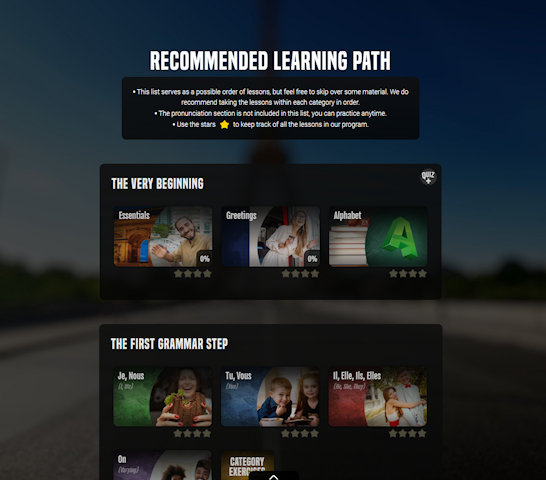The level system didn’t make much sense to us. Although some things are certainly more complex than others (you will find most of these in the Building Blocks lessons). The hardest and time-consuming part of learning a language is learning and remembering tons of words. For example, it is not harder to learn the word for monster than it is to learn the word for hello. Hello is just placed in level one because it is a very common word that everyone needs to know right away. Which makes perfect sense in this case, but the problem is that many words can be very important for some people, but insignificant for others (more on this later).
The fact is that the difficulty of a topic can’t always be associated with the learning level of someone. You can’t learn only easy content in the beginning and completely avoid the more difficult content. You need to learn words in terms of importance and frequency of use. For example, the verbs to be and to have are some of the most challenging verbs to learn in many languages, but should be learned at the beginning because they are used constantly. However, why would vocabulary words about clothing be in level one while body parts is in level three? There are aspects of the language that are important for everyone and other aspects that can vary from person to person, that is when the non-linear approach comes in.

We have to go from what is essentially an industrial model of education, a manufacturing model, which is based on linearity and conformity and batching people. We have to move to a model that is based more on principles of agriculture. We have to recognize that human flourishing is not a mechanical process; it’s an organic process. And you cannot predict the outcome of human development. All you can do, like a farmer, is create the conditions under which they will begin to flourish.Sir Ken Robinson

Another issue is that no one has the same definition of what a level is. If you learn from one system and then decide to choose another system, it is very hard to know which level you are at. You may be an intermediate in one system, but considered a beginner in another. You may be an intermediate in one system, but have seen a bit of beginner, intermediate and advanced material in other systems. The point is that it can be hard to go from one system to another without having to start again from scratch. Learning a language is a lengthy process and you may want to use more than one method.
This is why we decided to use a non-linear method of learning. This gives you control over your learning path and you can therefore learn the material that is most relevant to you. This makes Ouino fit more people than most systems because everyone with different needs can create their own learning style. This is a learning approach that we are known for and lots of people love it. You can be at pretty much any level and start learning from our program and focus on the material that is the most relevant to your needs.
We created the recommended path to fit most people, it starts with very frequently used words and includes a good balance of each module of the course. It is there to guide you if you need it. You can start at the first lesson and follow the path to the very last lesson. You can also switch back and forth from the recommended path and your own path. There are no strict rules and you will never be lost because your progress will be shown in the menu.
Having a strict path is a weakness in a learning program. We discovered that having no path at all can be a weakness as well. Using a non-linear approach with a recommended path to assist you if you need it is the best of both worlds.

If you want to succeed you should strike out on new paths, rather than travel the worn paths of accepted success.John D. Rockefeller